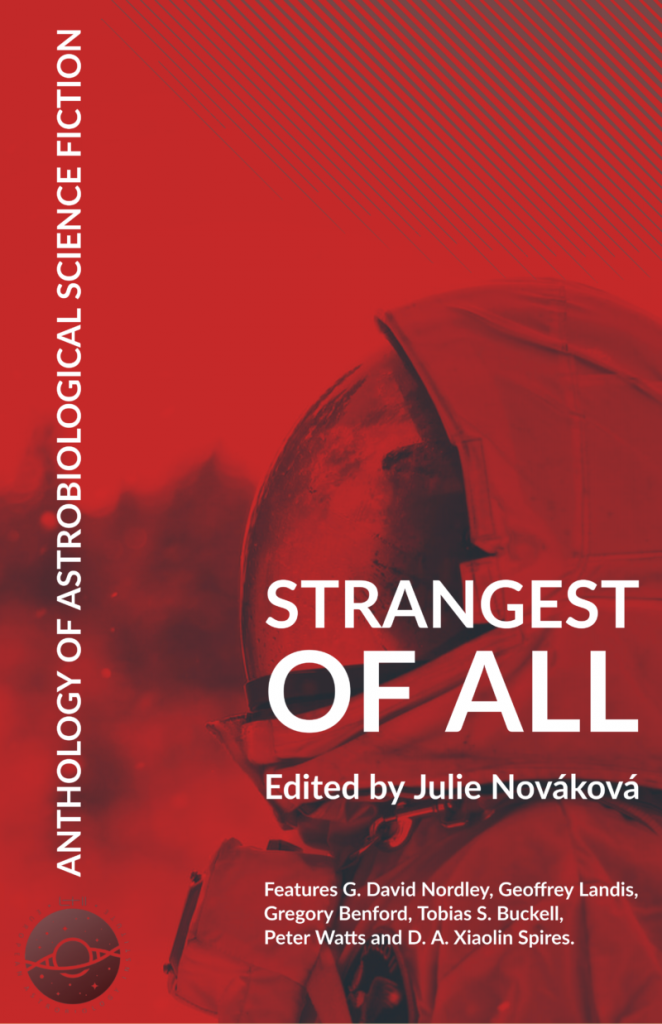Is anyone out there? From the possibility of microbial life on Mars and elsewhere in the solar system across the multitude of exoplanets all the way to the Fermi Paradox, astrobiology tries to find the answer to this age-old question and more – like how life originated here on Earth, what are its physical limits and what forms might life take under different conditions.
A new freely available anthology released by the European Astrobiology Institute delves into these questions via Science Fiction (SF) stories by world-renowned authors, followed by essays about the science of each story.
The anthology, titled Strangest of All (a nod to H. G. Wells’s War of The Worlds), was edited by the author, editor and scientist Julie Nováková, who leads the outreach working group of the European Astrobiology Institute. The book contains reprint SF stories by G. David Nordley, Geoffrey Landis, Gregory Benford, Tobias S. Buckell, Peter Watts and D. A. Xiaolin Spires, plus a bonus story by the editor.
Nordley’s “War, Ice, Egg, Universe” takes readers to an aquatic civilization inhabiting a Europa-like world with an ice-covered ocean, and the accompanying essay focuses on what we know about conditions for life on Europa, Enceladus, Ganymede and other ocean worlds. In “Into The Blue Abyss” by Landis, the protagonist dives into an entirely different ocean – the high-pressure liquid water layer on Uranus, where chemistry signifying possible life had been observed. Could life really exist in such conditions – and could high-pressure environments actually be one of the most common habitats in the universe?
Continuing the journey outward of the Sun, “Backscatter” by Benford finds life in an improbable place: an icy asteroid in the Kuiper Belt. The follow-up essay provides background on the possibility of life in asteroids and comets, and dives into the topic of exotic silicon-based life in such cold places with no liquid water.
In Buckell’s “A Jar of Goodwill”, we leave solar system and environments similar to it entirely, visiting a strange exoplanet where plants metabolize chlorine – but the main problem the hero faces is whether its ant-like inhabitants are intelligent creatures. Halogen-based photosynthesis was actually proposed in theory – so we can look at where we could expect such exotic life. Even more exotic is the titular creature in Watts’s novelette “The Island”: a live Dyson sphere. In the essay, we look at how we can search for Dyson spheres, what the surveys yielded up-to-date, and whether we could presume anything about the origin and thought processes of a nigh-impossible being like the Island.
Benford returns with a microstory “SETI for Profit”, an interesting take on how to revive interest in SETI. What efforts to listen to potential extra-terrestrial messages have been taken so far, and what can we expect in the future? The topic of SETI is inextricably linked with the Fermi Paradox, one of the themes of Spires’s “But, Still, I Smile”. How can we explain the paradox with what we know so far, and how does the explanation in the story relate to our world? Finally, in the bonus story by Nováková, “Martian Fever”, we look at Mars exploration gone awry – and the risks of interplanetary biological contamination and the question of planetary protection.
Each story is followed not only by the science essay complete with references for readers craving more, but also a couple of ideas for classroom discussions or tasks (best-suited for higher high school grades or undergraduate university students), such as thinking of how to devise a message for a potentially listening alien civilization, bearing in mind what we know of sensory and cognitive differences between species here on Earth. For most of the questions, there is no definitive answer – but all the more curiosity should they elicit.
Strangest of All is the first of major outreach projects coming from the European Astrobiology Institute (EAI). EAI was founded in 2019 with the aims to support interdisciplinary research in astrobiology across Europe and beyond, disseminate scientific results and promote education and outreach in astrobiology and related fields by organizing summer schools, supporting the AbGradE forum for graduate students and creating materials such as this book, among other ways. Astrobiology is an exciting and booming scientific field, and science fiction is a perfect tool to bring it closer to people and enable them to imagine the incessant drive of curiosity and the joy of discovery that are at the heart of both science and SF. More such efforts are considered by EAI’s project team “Science Fiction as a tool for Astrobiology Outreach and Education”, which also welcomes new members who are interested in developing similar outreach materials.
The anthology Strangest of All can be downloaded for free in several formats on the websites of the European Astrobiology Institute and the editor, Julie Nováková.
Links:
About the European Astrobiology Institute
About the editor, Julie Nováková
Strangest of All at the European Astrobiology Institute
Image


